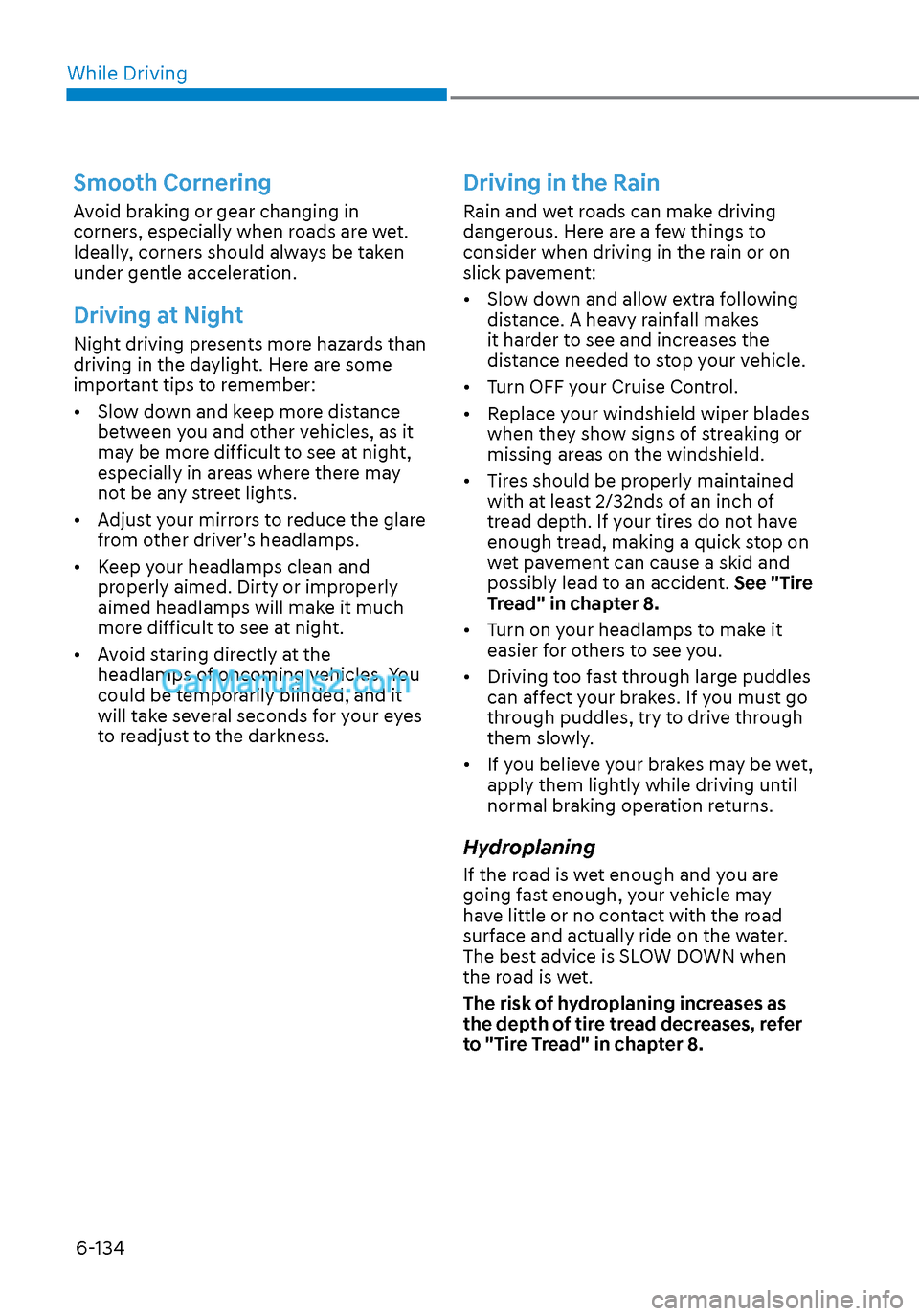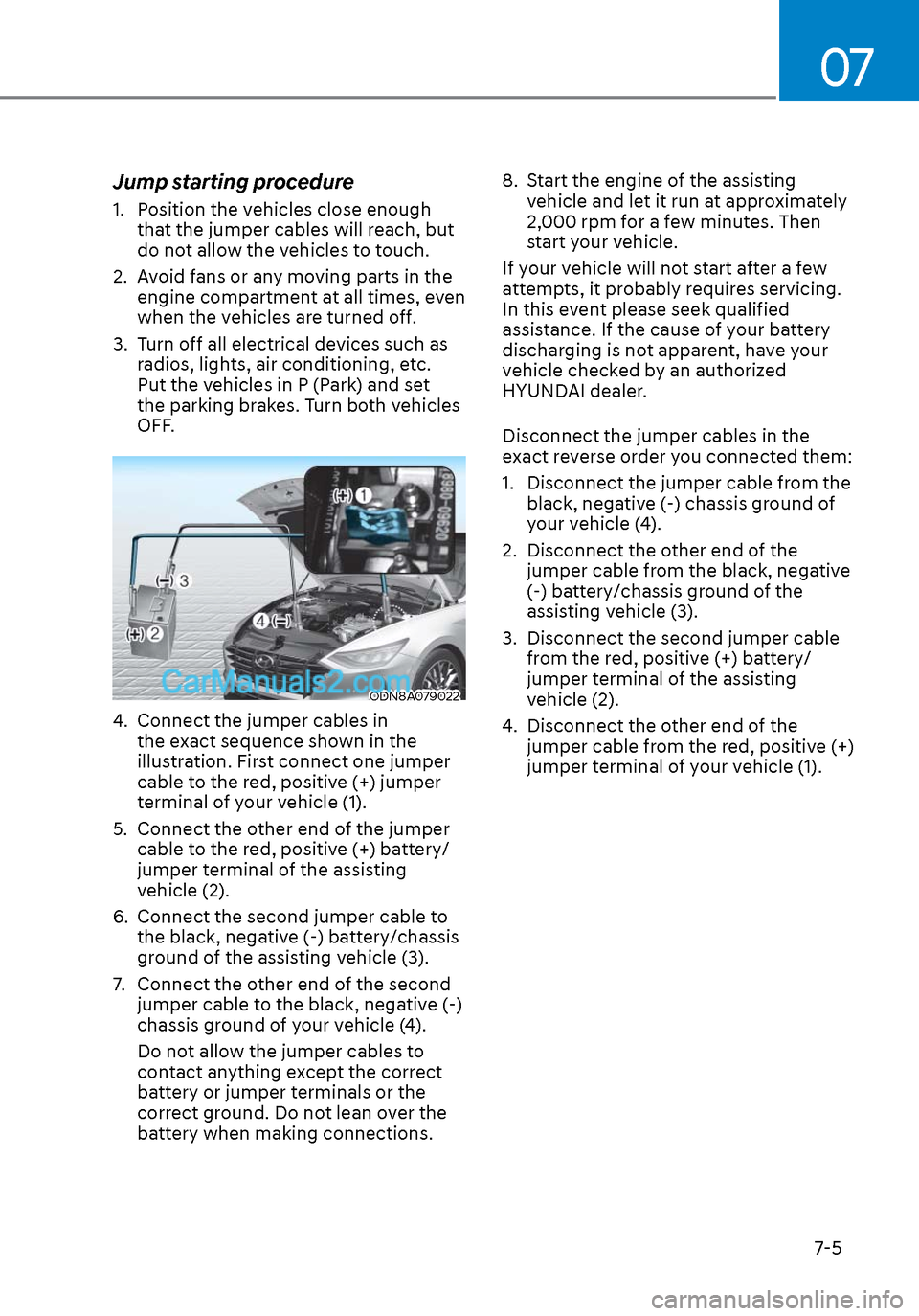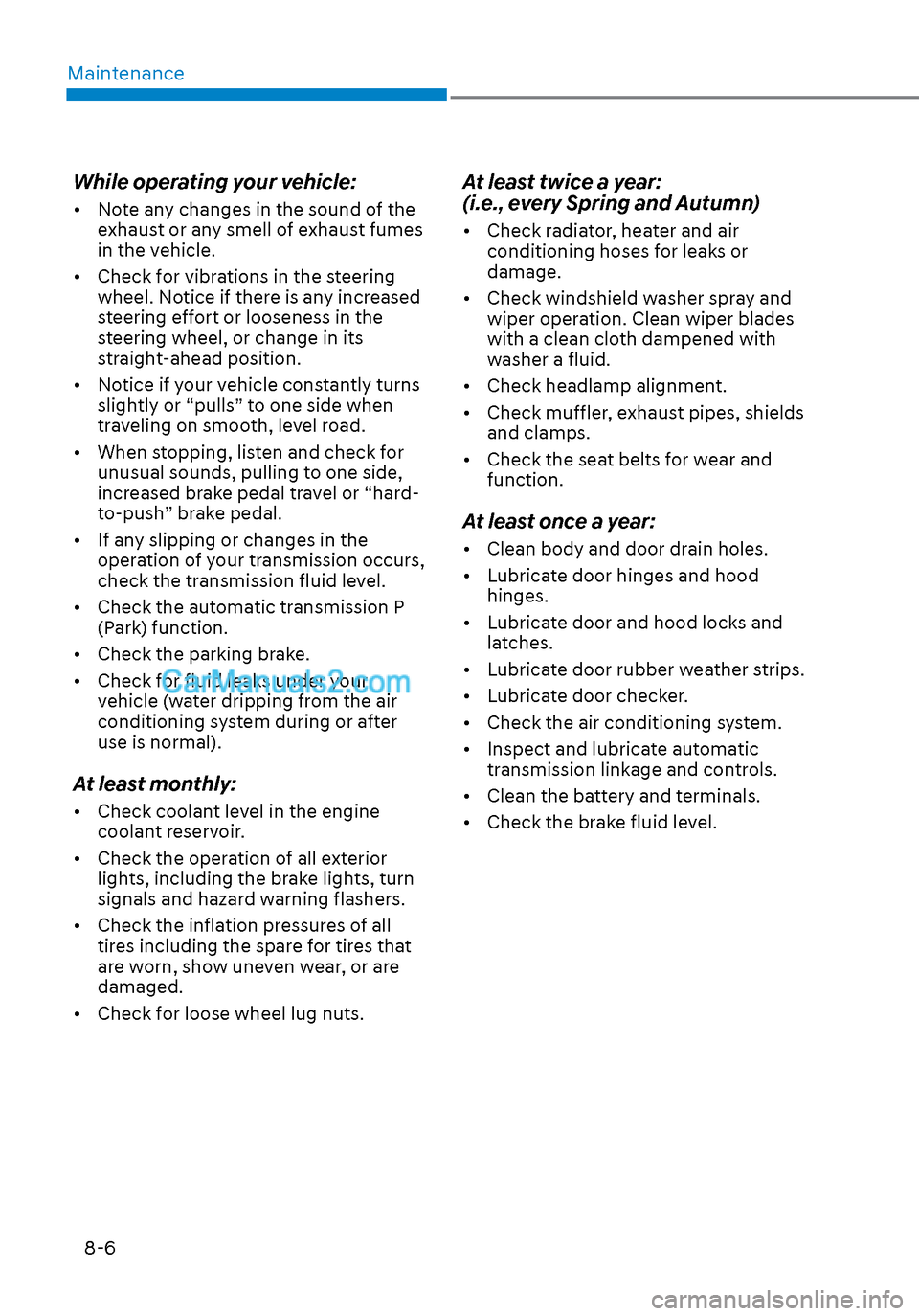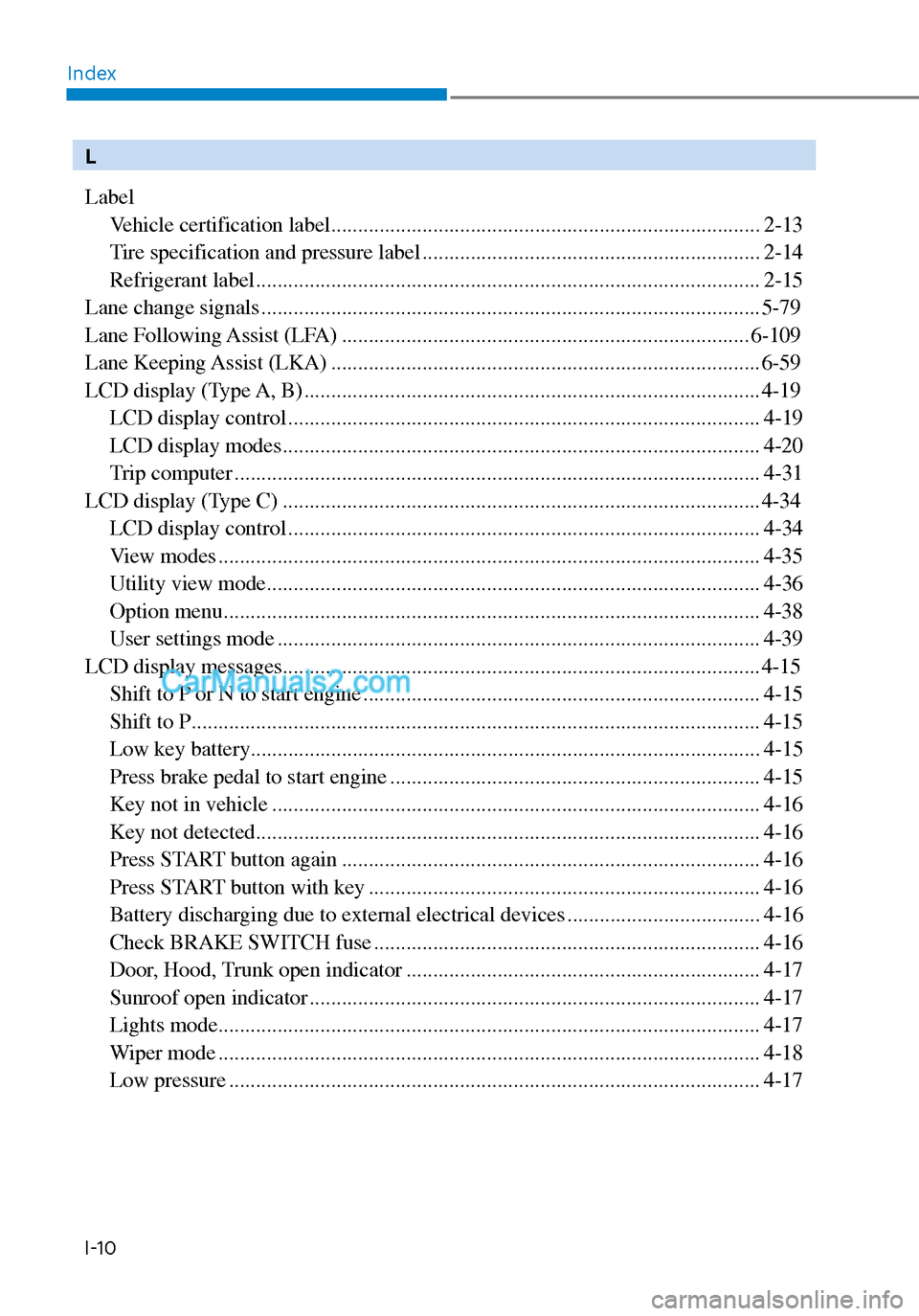2020 Hyundai Sonata Brake lights
[x] Cancel search: Brake lightsPage 317 of 537

06
6-33
The Idle Stop and Go (ISG) system
automatically and temporarily shuts
down the engine when the vehicle
is stopped and idling to improve fuel
efficiency and reduce exhaust gas
emissions. (i.e. red stop light, stop sign,
and traffic jam).
The engine is automatically started upon
satisfying the starting conditions.
The ISG system is always active, when
the engine is running.
Information
When the engine is automatically started
by the ISG system, some warning
lights (i.e. ABS, ESC, ESC OFF, EPS,
and parking brake warning light) may
illuminate for a few seconds due to the
low battery voltage. However, it does
not indicate a malfunction with the ISG
system.
To Activate the ISG System
Prerequisite for activation
The ISG system operates in the following
situations.
• The driver's seatbelt is fastened
• The driver's door and hood are closed
• The brake vacuum pressure is adequate
• The battery sensor is activated and the battery is sufficiently charged
• Outside temperature is not too low or too high
• The vehicle is driven over a constant speed and stops
• The climate control system satisfies the conditions
• The vehicle is sufficiently warmed up
• The incline is gradual
• The steering wheel is turned less than 180 degrees and then the vehicle
stops
Information
• The ISG system is not
activated, when the
prerequisites to activate
the ISG system are
unsatisfied. In this case,
the ISG OFF button indicator
illuminates, and the auto stop indicator
(
) illuminates in yellow on the
instrument cluster.
• When the above indicator remains
illuminated on the instrument cluster,
have the IGS system checked by an
authorized HYUNDAI dealer.
Auto stop
To stop the engine in idle stop mode
1. Decrease the vehicle speed to 0 mph.
2. Depress the brake pedal with the shift
button in D (Drive) or N (Neutral).
The auto stop indicator (
) illuminates
in green on the instrument cluster, when
the engine stops.
Information
The driving speed must reach at least 3
mph (5 km/h) after an idle stop to stop the
engine in idle stop mode again.
In auto stop mode, when the driver
opens the hood, the ISG system will be
deactivated.
ISG (IDLE STOP AND GO) SYSTEM (IF EQUIPPED)
Page 418 of 537

While Driving6-134
Smooth Cornering
Avoid braking or gear changing in
corners, especially when roads are wet.
Ideally, corners should always be taken
under gentle acceleration.
Driving at Night
Night driving presents more hazards than
driving in the daylight. Here are some
important tips to remember:
• Slow down and keep more distance between you and other vehicles, as it
may be more difficult to see at night,
especially in areas where there may
not be any street lights.
• Adjust your mirrors to reduce the glare from other driver's headlamps.
• Keep your headlamps clean and properly aimed. Dirty or improperly
aimed headlamps will make it much
more difficult to see at night.
• Avoid staring directly at the headlamps of oncoming vehicles. You
could be temporarily blinded, and it
will take several seconds for your eyes
to readjust to the darkness.
Driving in the Rain
Rain and wet roads can make driving
dangerous. Here are a few things to
consider when driving in the rain or on
slick pavement:
• Slow down and allow extra following distance. A heavy rainfall makes
it harder to see and increases the
distance needed to stop your vehicle.
• Turn OFF your Cruise Control.
• Replace your windshield wiper blades when they show signs of streaking or
missing areas on the windshield.
• Tires should be properly maintained with at least 2/32nds of an inch of
tread depth. If your tires do not have
enough tread, making a quick stop on
wet pavement can cause a skid and
possibly lead to an accident. See "Tire
Tread" in chapter 8.
• Turn on your headlamps to make it easier for others to see you.
• Driving too fast through large puddles can affect your brakes. If you must go
through puddles, try to drive through
them slowly.
• If you believe your brakes may be wet, apply them lightly while driving until
normal braking operation returns.
Hydroplaning
If the road is wet enough and you are
going fast enough, your vehicle may
have little or no contact with the road
surface and actually ride on the water.
The best advice is SLOW DOWN when
the road is wet.
The risk of hydroplaning increases as
the depth of tire tread decreases, refer
to "Tire Tread" in chapter 8.
Page 433 of 537

07
7-5
Jump starting procedure
1. Position the vehicles close enough that the jumper cables will reach, but
do not allow the vehicles to touch.
2. Avoid fans or any moving parts in the engine compartment at all times, even
when the vehicles are turned off.
3. Turn off all electrical devices such as radios, lights, air conditioning, etc.
Put the vehicles in P (Park) and set
the parking brakes. Turn both vehicles
OFF.
ODN8A079022ODN8A079022
4. Connect the jumper cables in the exact sequence shown in the
illustration. First connect one jumper
cable to the red, positive (+) jumper
terminal of your vehicle (1).
5. Connect the other end of the jumper cable to the red, positive (+) battery/
jumper terminal of the assisting
vehicle (2).
6. Connect the second jumper cable to the black, negative (-) battery/chassis
ground of the assisting vehicle (3).
7. Connect the other end of the second jumper cable to the black, negative (-)
chassis ground of your vehicle (4).
Do not allow the jumper cables to
contact anything except the correct
battery or jumper terminals or the
correct ground. Do not lean over the
battery when making connections. 8. Start the engine of the assisting
vehicle and let it run at approximately
2,000 rpm for a few minutes. Then
start your vehicle.
If your vehicle will not start after a few
attempts, it probably requires servicing.
In this event please seek qualified
assistance. If the cause of your battery
discharging is not apparent, have your
vehicle checked by an authorized
HYUNDAI dealer.
Disconnect the jumper cables in the
exact reverse order you connected them:
1. Disconnect the jumper cable from the black, negative (-) chassis ground of
your vehicle (4).
2. Disconnect the other end of the jumper cable from the black, negative
(-) battery/chassis ground of the
assisting vehicle (3).
3. Disconnect the second jumper cable from the red, positive (+) battery/
jumper terminal of the assisting
vehicle (2).
4. Disconnect the other end of the jumper cable from the red, positive (+)
jumper terminal of your vehicle (1).
Page 453 of 537

Maintenance8-6
While operating your vehicle:
• Note any changes in the sound of the exhaust or any smell of exhaust fumes
in the vehicle.
• Check for vibrations in the steering wheel. Notice if there is any increased
steering effort or looseness in the
steering wheel, or change in its
straight-ahead position.
• Notice if your vehicle constantly turns slightly or “pulls” to one side when
traveling on smooth, level road.
• When stopping, listen and check for unusual sounds, pulling to one side,
increased brake pedal travel or “hard-
to-push” brake pedal.
• If any slipping or changes in the operation of your transmission occurs,
check the transmission fluid level.
• Check the automatic transmission P (Park) function.
• Check the parking brake.
• Check for fluid leaks under your vehicle (water dripping from the air
conditioning system during or after
use is normal).
At least monthly:
• Check coolant level in the engine coolant reservoir.
• Check the operation of all exterior lights, including the brake lights, turn
signals and hazard warning flashers.
• Check the inflation pressures of all tires including the spare for tires that
are worn, show uneven wear, or are
damaged.
• Check for loose wheel lug nuts.
At least twice a year:
(i.e., every Spring and Autumn)
• Check radiator, heater and air conditioning hoses for leaks or
damage.
• Check windshield washer spray and wiper operation. Clean wiper blades
with a clean cloth dampened with
washer a fluid.
• Check headlamp alignment.
• Check muffler, exhaust pipes, shields and clamps.
• Check the seat belts for wear and function.
At least once a year:
• Clean body and door drain holes.
• Lubricate door hinges and hood hinges.
• Lubricate door and hood locks and latches.
• Lubricate door rubber weather strips.
• Lubricate door checker.
• Check the air conditioning system.
• Inspect and lubricate automatic transmission linkage and controls.
• Clean the battery and terminals.
• Check the brake fluid level.
Page 529 of 537

IndexI-10
L
Label Vehicle certification label ........................................................................\
........ 2-13
Tire specification and pressure label ............................................................... 2-14
Refrigerant label ........................................................................\
...................... 2-15
Lane change signals ........................................................................\
..................... 5-79
Lane Following Assist (LFA) ........................................................................\
.... 6-109
Lane Keeping Assist (LKA) ........................................................................\
........ 6-59
LCD display (Type A, B) ........................................................................\
............. 4-19 LCD display control ........................................................................\
................ 4-19
LCD display modes ........................................................................\
................. 4-20
Trip computer ........................................................................\
.......................... 4-31
LCD display (Type C) ........................................................................\
................. 4-34
LCD display control ........................................................................\
................ 4-34
View modes ........................................................................\
............................. 4-35
Utility view mode ........................................................................\
.................... 4-36
Option menu ........................................................................\
............................ 4-38
User settings mode ........................................................................\
.................. 4-39
LCD display messages ........................................................................\
................. 4-15
Shift to P or N to start engine ........................................................................\
.. 4-15
Shift to P ........................................................................\
.................................. 4-15
Low key battery.........................................................\
...................................... 4-15
Press brake pedal to start engine ..................................................................... 4-15
Key not in vehicle ........................................................................\
................... 4-16
Key not detected ........................................................................\
...................... 4-16
Press START button again ........................................................................\
...... 4-16
Press START button with key ........................................................................\
. 4-16
Battery discharging due to external electrical devices .................................... 4-16
Check BRAKE SWITCH fuse ........................................................................\
4-16
Door, Hood, Trunk open indicator .................................................................. 4-17
Sunroof open indicator ........................................................................\
............ 4-17
Lights mode ........................................................................\
............................. 4-17
Wiper mode ........................................................................\
............................. 4-18
Low pressure ........................................................................\
........................... 4-17
Page 536 of 537

I
I-17
V
Vanity mirror lamp ........................................................................\
....................... 5-82
Vehicle break-in process ........................................................................\
................ 1-7
Vehicle certification label ........................................................................\
............ 2-13
Vehicle identification number (VIN) ................................................................... 2-13
Vehicle load limit ........................................................................\
....................... 6-139Tire loading information label ....................................................................... 6-139
Vehicle modification ........................................................................\
...................... 1-7
Vehicle Stability Management (VSM)................................................................. 6-31
Vehicle weight and luggage volume .................................................................... 2-10
W
Warning and indicator lights ........................................................................\
.......... 4-7
Air bag warning light ........................................................................\
................ 4-7
Seat belt warning light ........................................................................\
.............. 4-7
Parking brake & brake fluid warning light ....................................................... 4-8
Anti-lock Brake System (ABS) warning light .................................................. 4-9
Electronic brake force distribution (EBD) system warning light ...................... 4-9
Electric Power Steering (EPS) warning light .................................................... 4-9
AUTO HOLD indicator light ........................................................................\
.. 4-10
Electric Power Steering (EPS) warning light .................................................. 4-10
Malfunction Indicator lamp (MIL)......................................\
............................ 4-10
Charging system warning light ...................................................................... 4-11
Engine oil pressure warning light .................................................................. 4-11
Low fuel level warning light ........................................................................\
.. 4-11
Master warning light ........................................................................\
............... 4-11
Low tire pressure warning light ...................................................................... 4-11
Electronic stability control (ESC) indicator light....................\
........................ 4-11
Electronic stability control (ESC) OFF indicator light ................................... 4-13
Immobilizer indicator light ........................................................................\
..... 4-13
Turn signal indicator light ........................................................................\
....... 4-14
Headlamp warning light ........................................................................\
.......... 4-14
High beam indicator light...............................................\
................................. 4-14
High Beam Assist (HBA) indicator light ........................................................ 4-14
Light ON indicator light ........................................................................\
.......... 4-14
Forward Collision-Avoidance Assist warning light ........................................ 4-15
Lane Keeping Assist indicator light ................................................................ 4-15
Washer fluid ........................................................................\
................................. 8-25